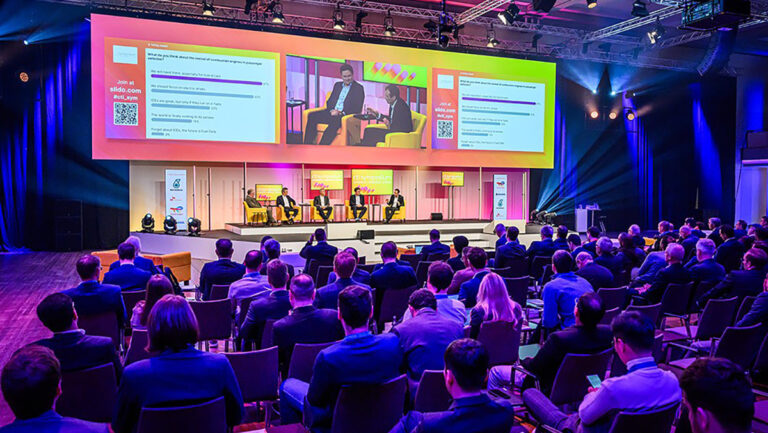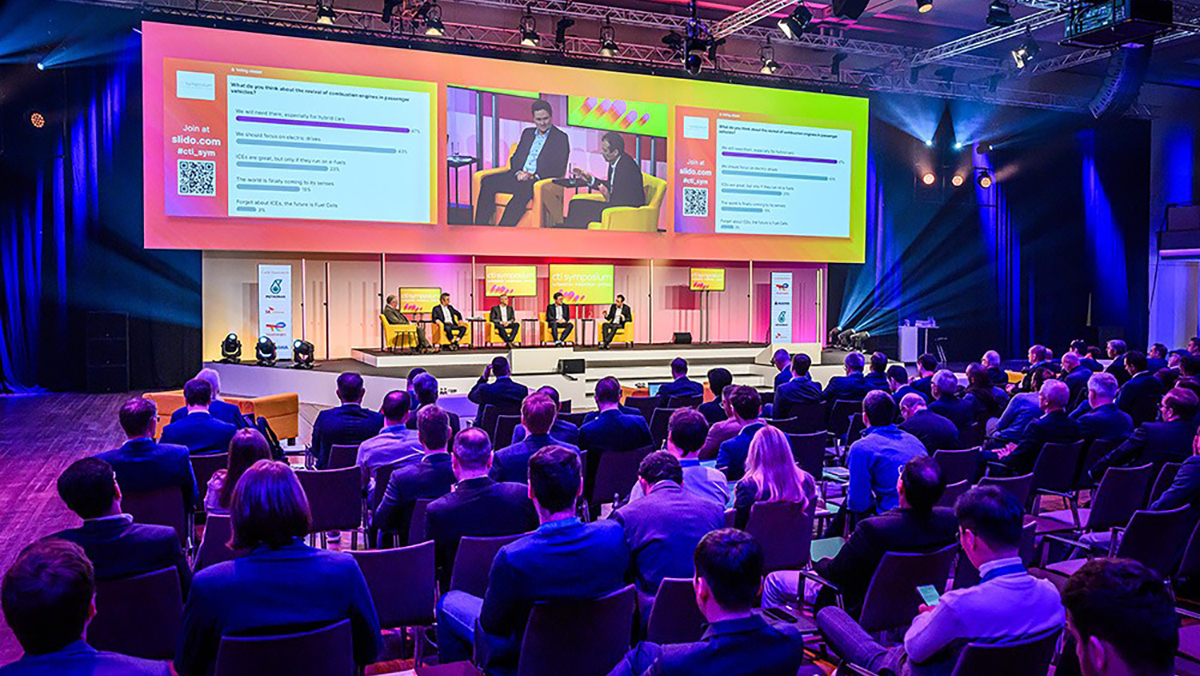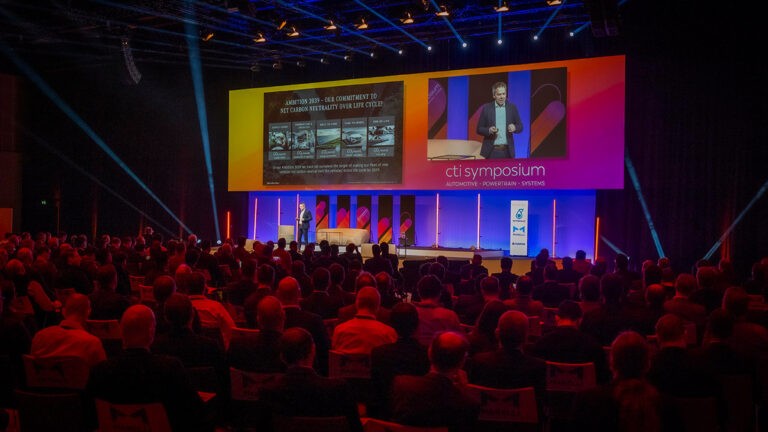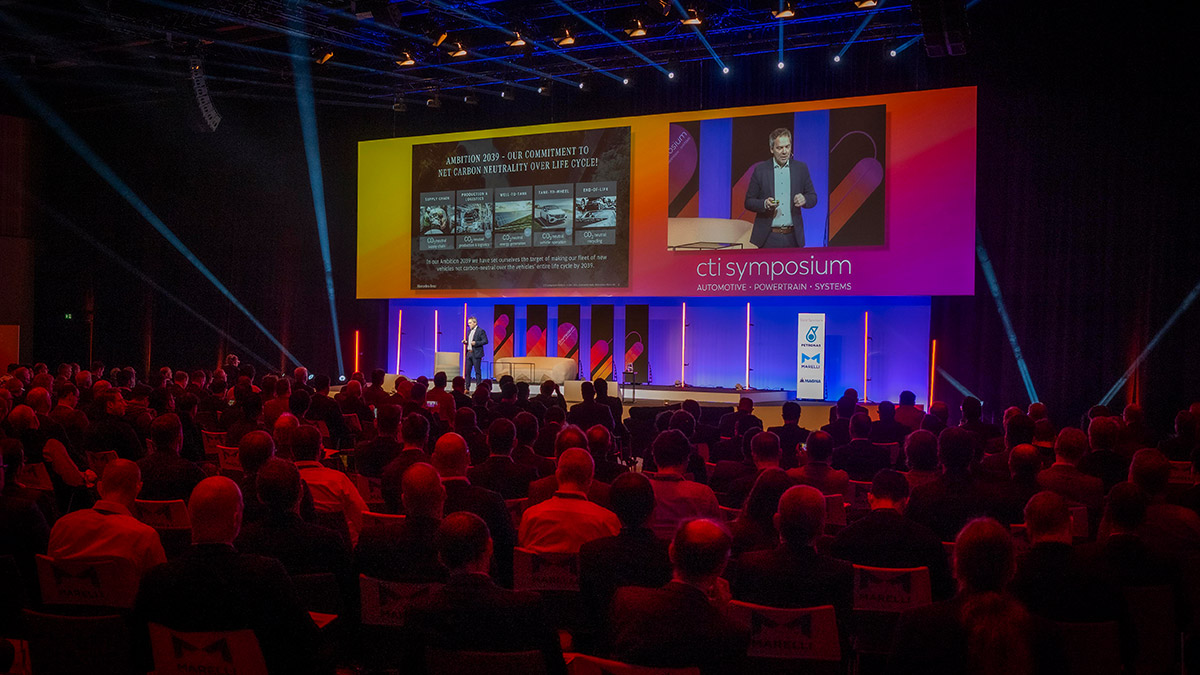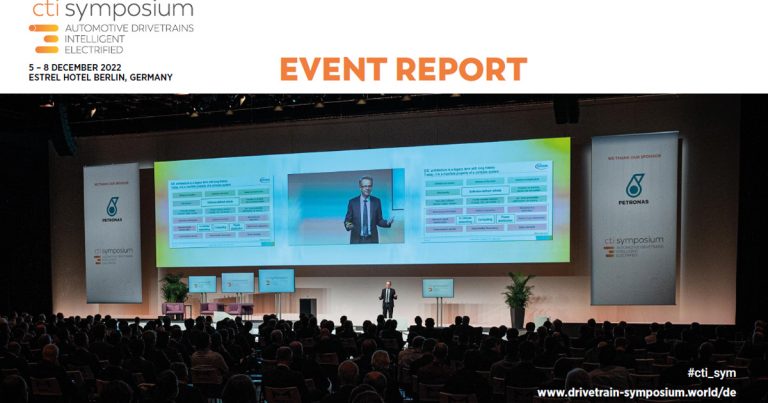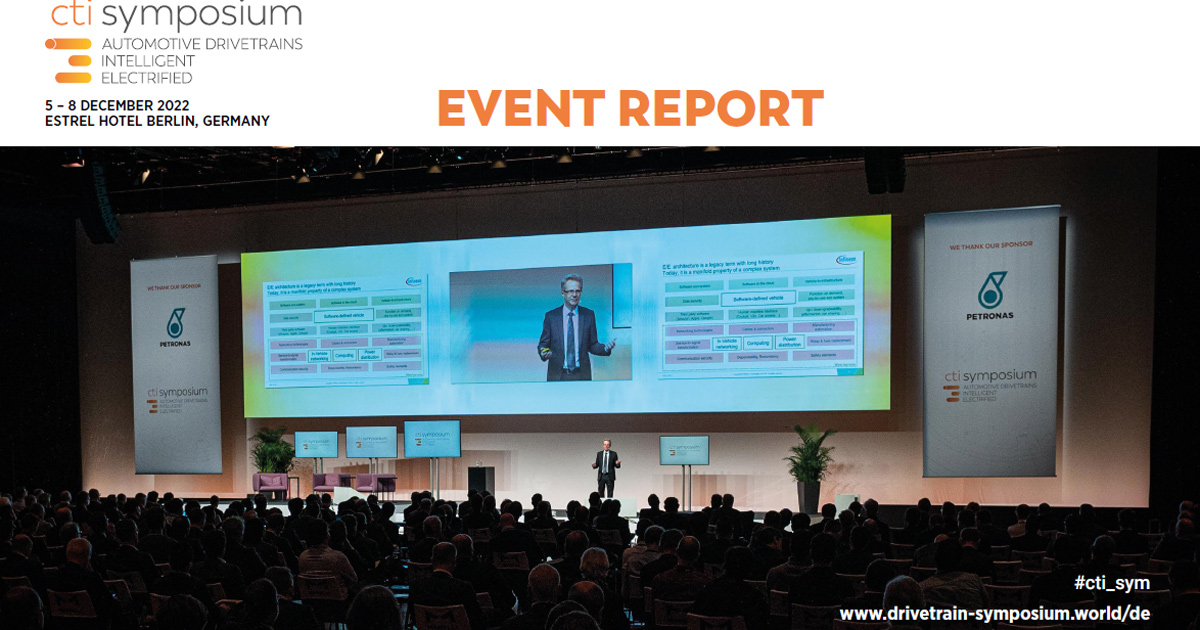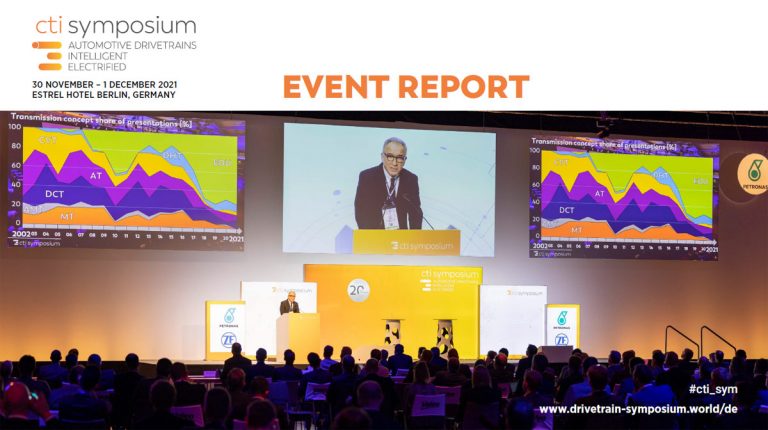Post Show Report

Electric First – Where Possible
In 2024, the electrification process in Europe stuttered – but as the discussions at the 27th CTI Symposium made clear, it is not about to stop. Other interesting topics in Berlin included insights on India as a future market or advances in digitalization and artificial intelligence. And the Software-Defined Vehicle is about to become more […]
Continue readingElectric First – Where Possible
In 2024, the electrification process in Europe stuttered – but as the discussions at the 27th CTI Symposium made clear, it is not about to stop. Other interesting topics in Berlin included insights on India as a future market or advances in digitalization and artificial intelligence. And the Software-Defined Vehicle is about to become more than a buzzword.
2024 had several surprises for the automotive industry, particularly the lack of European sales figures for all-electric passenger BEVs. That does not signal the demise of electromobility; after all, no sector ever experiences uninterrupted growth. But it has revived the topic of plug-in hybrids, or more precisely, a new type of range extender known as EREVs (Range Extended Electric Vehicles) or REEVs. These highly electrified serial or serial-parallel hybrids are standard fare in China today.
Naturally, these developments also played a role at the CTI Symposium Berlin, which took place on December 3 and 4, 2024, at the usual venue, Estrel Hotel in Neukölln, Berlin. Hosted by Prof. Malte Jaensch, Chair of Sustainable Mobile Powertrains at the Technical University of Munich, there were three key themes in the plenary lectures and panel discussions: How are markets and regulations developing in Europe and future markets such as India? Which drive concepts are gaining ground in passenger cars and commercial vehicles? Finally, a topic playing an increasingly important role: digitalization and new opportunities based on artificial intelligence.
India – the next big market?
For some observers, India is an upcoming market with great potential. In his lecture “Indian Automotive Market – Trends and Regulation Insights”, Amit Gupta, CEO of Hero Motors, provided some statistics: India is the world’s fifth largest market economy, with a population of 1.43 billion. With a median age of just 29.5 years (compared to 42.5 in Europe), India is a very young country with vast potential for future car buyers. Gupta divided developments over the last few decades into five phases: Before 1982, there were just five car manufacturers, all Indian companies. From 1983 to 1991, Maruti dominated the market. From 1991 to 2010, a good 20 companies emerged, offering mainly small cars. By 2020, premium vehicles and (like everywhere else in the world) SUVs increasingly entered the mix. Then, after 2020, electrification gained momentum in India, and exports grew. Hero Motors itself supplies a range of drive components. Gupta said electrification in India had gained momentum recently, rising to around 1.7 million electric vehicles in 2024 from around 146,000 in 2010. However, more than half of these were two-wheelers. Incidentally, this growth was supported by a program called „Faster Adoption and Manufacturing of Electric Vehicles“ (FAME II), which expired in March 2024.
Is regulation harmful or valuable?
That leads to the question of how far regulations can assist in introducing new technology – or as the first panel discussion put it: „Does Regulation Kill Innovation?” The participants were Dr. Peter Mock, Managing Director of ICCT Europe, Dr. Manfred Schuckert, Head of Regulatory Strategy & Int. Hydrogen Strategy, Daimler Truck AG, and Hui Zhang, Managing Director NIO Europe. The moderator was Ulrich Walter.
Manfred Schuckert called for regulations that are properly thought through. Specifically, he criticized the tank-to-wheel model still used in Europe, which ignores all other CO₂ emissions during the product cycle. By this logic, he noted ironically, even when hydrogen is burned – a process that is CO₂-neutral – the CO₂ from the intake air gets measured at the exhaust. Schuckert also pointed out that commercial vehicle manufacturers, particularly, depend on the energy infrastructure. Drawing politicians’ attention to requirements such as the number of charging stations needed for electric truck fleets, he said, was a complex and ongoing task. He also questioned whether political regulations are always implemented at the desired speed. He said that the EU Commission is often unwilling to follow industry recommendations; things were very different in China.
Peter Mock, in contrast, came out in favor of legal regulations. He also opposed that relaxing European regulations was justified if emissions were shifted to other world regions. Asked whether it might now be time to make up with the industry after Dieselgate, he replied: „No, this completely destroyed the relationship, basically because it was just one scandal too many.“ Mock said the entire automotive industry had lied for years and was astonished that the industry now „dared“ to appeal to the government once again, arguing that the jobs it provided were crucial.
In addition to his role as a representative of carmaker Nio, Hui Zhang provided some interesting insights into how a Chinese expert perceives matters. He said the EU was over-regulated, an opinion he backed up with corresponding statements made by Emmanuel Macron. Zhang said every innovation needs space for competition first; regulations should only be the next step. In other words: „Be open-minded before you start regulating.“ Zhang also said that normal consumers need incentives. They were cost-driven, and in this sense, „the user is always right“. Energy costs in Germany were far too high, and it was only natural for users to react.
Securing raw materials and energy sources
Regarding energy and raw materials, Karin Pittel, ifo Institute, offered extensive insights and several recommendations in her lecture: „Building a Sustainable Mobility Future: Challenges from Energy and Resource Markets“. She said the availability of lithium, and even more so of cobalt, was critical, especially since Germany depended 100 percent on imports. Otherwise, fossil fuels such as oil, gas, and coal would still be around for a long time, and prices were likely to fall. This, in turn, would make electric cars less attractive to buyers. The switch to hydrogen is not that easy either, said Pittel, as production and consumption sites are scattered around the globe. She closed on the topic of supply chain disruption, saying this hit Germany harder than other Western countries during Covid-19, cutting productivity there by 8 percent. So, what can we do in the face of all these dependencies? Pittel believes we must diversify more, improve cooperation in Europe, and closely examine how we view conflicts between economic and humanitarian objectives. We need to strengthen our information base to identify risks early – and not forget the need to “really do something”, which typically can happen when the alertness after a crisis goes down.
Are swappable batteries coming?
In addition to participating in the first panel discussion, Hui Zhang also lectured on „Nio’s Power Strategy for Europe – Combining Mobility and Energy Transition“. Nio was founded in China in 2014 and has around 1,000 employees in Europe, with sites in Germany in Berlin, Brandenburg, and Munich. Nio currently operates 2,500 Power Swap Stations worldwide, with 58 in Europe at the end of 2024. So, what are the advantages of swappable batteries? According to Zhang, they are as fast as refueling – even fast charging doesn’t come close. And with automatic swapping, you don’t even have to leave your car. Vehicle prices are less dependent on the battery, and the batteries will be checked every time you swap. You can even swap to a different-size battery if needed. When a delegate asked whether a swap system would not require more batteries, Zhang cited this greater flexibility as a counter-argument. As the lecture title made clear, Zhang also sees exchange batteries as part of the energy infrastructure, saying they can be part of a grid while stored at the swap stations. It will be interesting to see whether Nio succeeds in the European market. By the way, drivers can charge their swap battery EVs directly like any other EV.
BEVs and supplementary hydrogen for long hauls
As Christian Krajewski, Daimler Truck AG, showed in his lecture „Daimler Truck on the Way to CO₂ Neutrality”, Daimler Truck’s primary strategy for its commercial vehicles is BEV, with fuel cell for long-haul applications too. As the speaker pointed out, the EU requires commercial vehicles to emit 15 percent less CO₂ from 2025 on and 45 percent less by 2030, compared to 2019. The Daimler Truck portfolio includes the eActros 300/400 models for medium-range work, the eActros 600, and the GenH2 Truck with fuel cell. In his lecture, Krajewski focussed on the eActros 600. Its range is 500 km from a 621 kWh battery, and it can charge from 20 to 80% in less than half an hour using megawatt charging. Efficiency is always 95% or higher. Instead of a central drive, Daimler has opted for an eAxle, which is more compact and efficient. At 750 V, the drive delivers 600 kWp and 400 kW of continuous power. Inverter-to-wheel efficiency is 92%, while wheel torque tops 40,000 Nm. The four-speed gearbox is interesting, with steps 1/2 and 3/4 implemented as powershifts. Krajewski said Daimler still saw fuel cells as suitable for long-haul transportation. He is not in favor of H2 combustion engines, given the load profile of heavy trucks meant that fuel cells would use hydrogen more efficiently.
Electrification keeps the ICE running
Do combustion engines still have a future? That question was highly topical, given the modest BEV sales figures in 2024. Under the heading „Back from the Dead? ICE in Passenger Vehicles“, moderator Ulrich Walter discussed the issue with Dr. Norbert Alt, FEV, Prof. Maximilian Brauer from the TU Berlin, Dr. Tobias Block from the eFuel Alliance, and Prof. Markus Lienkamp from the TU Munich.
As head strategist of the eFuel Alliance, it was no surprise that Tobias Block sees a future for combustion engines. But he also spoke about the challenges of offering eFuels in sufficient quantities in the EU. He said there won’t be many investments if the legislation only focuses on niche markets. For example, in 2030, there would be only 0.7 % eFuels mandates for aviation and only 1 % for the maritime sector. Another example is that eFuel makers had to produce eFuels using only renewable electricity from installations not older than 36 months. BEVs otherwise were allowed to use fossil-based electricity. Block also cited a joint study with Porsche Consulting. Based on tracking data from 430 projects, the study predicts an annual worldwide production volume of 11 billion liters of eFuels in 2030. Block believes consumers should have the opportunity to run combustion engines on CO₂-neutral fuels if they wish.
Norbert Alt spoke passionately in favor of electrification. Technically, photovoltaic charging power could be produced for 10 cents/kWh in Germany, allowing people to opt for BEVs immediately. However, Germany needed to speed up development activities. Otherwise, „the Chinese will end up doing everything“. Interestingly, Alt pointed out that most development work on combustion engines now also takes place in China, saying Germany should not yield its position in that field either. Looking ahead, he sees combustion engines primarily as part of REEVs, or range extended electric vehicles. These were a major trend in China, and they would also be coming to Europe. REEVs were basically variants of electric platforms with a long electric range, designed as serial or serial-parallel hybrids. Technology-wise, serial hybrids were a simple solution – and with modern inverters, conversion losses no longer played a significant role.
Markus Lienkamp said hydrogen was not an option for him, as it was simply not affordable. Based on a realistic energy mix, the Technical University of Munich had calculated that due to the battery’s CO₂ burden, BEVs made less sense than rental cars for annual mileages under 5,000 km. Specific low-mileage applications, such as fire trucks, could run on eFuels. However, diesel might be preferable in terms of overall environmental impact. In principle, despite the current slump, the long-term trend was for BEVs. Lienkamp advocated using a push-pull strategy to nudge consumers in that direction.
Taking up the discussion’s title question, Maximilian Brauer began by saying that hybrids, and hence combustion engines, were actually experiencing steady growth, not a revival. Like his fellow participants, he expects all-electric drives to dominate in the future. Still, he also believes in creating a level playing field for eFuels. In terms of technology, Brauer says German manufacturers definitely do not lag behind China. His take on consumer behavior in Germany was succinct: „As long as BEVs stay expensive, people will stick with combustion engines.“
Summing up, all the participants agreed on two points: Electrification comes first; combustion engines will still be around, albeit mainly as servants in highly electrified vehicle platforms.
AI agents assist drivers
‘Digitalization and AI methods’ is a topic of growing importance at the CTI Symposium. There were two plenary lectures on the subject – one from Sabine Calvo, Renault, and the other from William Wei, FTP Automotive.
William Wei focused on how AI ‘agents’ can help drivers operate their vehicles more efficiently. Up to now, the vehicle code has been static, making functions and their operation fixed and rigid. The future belonged to ‘agents’ powered by AI and Large Language Models (LLM) with functionality that was neither static nor fixed but defined through end-to-end training. This method trains systems as a whole, not as separate functional modules. Wei spoke of the ‘brain’ of the car, saying drivers could, for example, operate their vehicle by communicating with it freely. In the next era of the „software defined vehicle,“ Wei foresees an AI infrastructure that is integrated down to chip level – a form of in-car Edge AI Computing. Functional safety, however, (for example during autonomous driving) was always rule-based, and hence required its own safety layer in the vehicle. This layer would sit as a safeguard between the vehicle sensors and the LLMs and agent level.
Digital Twin in all development stages
Dr. Sabine Calvo is Vice President Engineering Performance, Validations & Digital Transformation at the Renault Group. She described „How Digital Transformation will Support Breakthrough in Time-To-Market Acceleration and Cost Reduction” using various examples. Renault now needed just two years to develop a car. Digital Twin played a significant role in practically all vehicle functions. As a result, validation costs have been halved since 2019, she said. Calvo named three steps in digital simulation: The vehicle, the embedded systems, and immersive simulation. As a vehicle example, she used a crash test with a digital twin, showing almost no difference between simulation and reality. Other fields included aerodynamics, acoustics, strength, and thermal management. Examples of embedded systems include ADAS, systems & software, and energy management. Here, Calvo noted that virtual ADAS covered several million kilometers in 2024. Immersive simulation is used to simulate the design of car interiors – again, with hardly any visible differences. Renault also operates a closed driving simulator that allows drivers to experience the properties of the digital twin. Finally, Calvo touched briefly on AI, saying it was already used to make pre-development design suggestions. This led to prototypes with higher functional maturity at lower costs for physical tests.
Digital, Circular, Electric
In his lecture „Innovation as Driver of the Future,” Rudolf Bencker, BMW, named three core focus areas: „Digital, Circular and Electric.“ In digitalization, BMW backs features including panoramic in-vehicle displays, in-car gaming, mixed reality or the „Car Expert” – an AI-like in-car assistant based on large language models (LLM). At BMW, Circular Economy includes the use of new materials, circular manufacturing, and more efficient use of resources in general. While BMW is known for its open-minded approach to drive technology, the manufacturer’s BEVs are remarkably successful – the company sold its one-millionth BEV in 2024. BMW also continues to pursue plug-in hybrids, combustion engines, and fuel cell drives such as the one in the iX5. This comprises a 170 kW buffer battery, the 295 kW electric motor, the 125 kW fuel cells, and hydrogen tanks with a capacity of 6 kg. Even for passenger cars, Bencker sees hydrogen as a building block that can help to diversify energy infrastructures in regions with few charging options or when high-speed refueling is essential.
Electrification, AI and new markets
Of course, the animated discussion about the pros and cons of various drive concepts at the 27th CTI Symposium was not the first of its kind. In his summary, chair Prof. Malte Jaensch shared his opinion of BEVs, saying the right strategy is quite simple: Where possible, electrify. Where not, use hydrogen if possible or e-fuels if not. For passenger cars at least, this was a very simple rule of thumb. Jaensch was equally clear on AI, saying it may still be primarily about in-vehicle operation, as William Wei showed in his lecture, but AI in cars would develop rapidly. Today, AI helped us open windows; tomorrow it would help to improve autonomous driving; and after that, who knows? Jaensch followed up with two more insights: First, we should bear in mind that India is currently the only large market with strong growth potential. Second, a reminder to politicians: Dependable regulation is at least as important as „correct“ regulation.
Given the recent political upheavals, this will likely be a challenging task in 2025 for the industry. The next opportunity to discuss future opportunities and technologies will be at the CTI Symposium Novi
in Michigan (May 13 and 14, 2025). There will also be special events for women in automotive, students, young professionals, and startups in the powertrain industry. We warmly invite you to participate as a speaker, delegate or exhibitor!
The Powertrain as an Intelligent System
The automotive world is changing, and the CTI Symposium is helping to drive the transformation. Where will the boundaries of powertrains lie in future? While powertrains will still be centre stage of the Symposium, the scope will expand. Artificial intelligence will play a growing role, and so will the provision of energy sources. The 22nd […]
Continue readingThe Powertrain as an Intelligent System
The automotive world is changing, and the CTI Symposium is helping to drive the transformation. Where will the boundaries of powertrains lie in future? While powertrains will still be centre stage of the Symposium, the scope will expand. Artificial intelligence will play a growing role, and so will the provision of energy sources.
The 22nd CTI Symposium 2023 in Berlin (5 – 6 December) began with an important announcement, as Prof. Ferit Küçükay handed over his role as chairperson to Prof. Malte Jaensch. Jaensch’s primary role is Chair of Sustainable Mobile Powertrain at the Technical University of Munich. Professor Küçükay will stay with the Symposium in the role of Founding Chairman. Malte Jaensch justifiably praised his predecessor’s work for CTI as a “lifetime achievement.”
For nearly 25 years, Professor Küçükay shaped the themes of the CTI Symposium, and oversaw a number of paradigm shifts along the way. It all began in late 2000, just after Professor Küçükay became head of the Institute of Automotive Engineering at the TU Braunschweig. One day, he took a call from Sylvia Zenzinger, now the symposium’s conference director. Would he be interested in chairing a new congress on vehicle drives? Küçükay agreed right away.
Since then, both the Symposium’s topics and its tagline have evolved steadily. In 2010, hybrid and electric drives were added to the programme and tagline. Recently, “Automotive Drivetrains, Intelligent, Electrified” has reflected the growing importance of electrification. Today, the CTI Symposium is a major international event, with presentations held exclusively in English.
This December, the Symposium changed its tagline to “Automotive Powertrain Systems”. This reflects two current developments: Firstly, that electrification is now a perfectly normal powertrain topic; secondly, that adopting a system view is crucial when developing vehicle drives.
The BEV for Everybody
As Professor Malte Jaensch specified in his opening speech, we need to consider the powertrain as a system and understand how all the individual components work. That starts with electric motors, gearboxes for elctric drives, inverters and batteries – and extends right up to the overall vehicle and, of course, the consumers’ wishes.
With BEVs, another question is how to make them affordable for everyone. In Berlin, this was the focus of the Executive Discussion “The BEV for Everybody”, with participants Karsten Bennewitz, Volkswagen, Marcus Lott, Opel, Prof. Maximilian Fichtner, Helmholtz Institute Ulm, and David Green from Lynk.
The first question was, “When will BEVs dominate the vehicle market?” Using their voting app, the majority of audience members said it would be when cost parity was achieved with other drive types. In second place came adequate infrastructure, followed by sufficient range and/or faster charging times.
On costs, Bennewitz agreed that we need to approach cost parity, but said Germany already had an adequate charging infrastructure, with high numbers of fast charging stations. He cited fun-to-drive as a further important factor for winning over consumers to BEV. From an OEM perspective, he does not foresee an immediate switch to BEV, saying markets such as India had totally different requirements.
Marcus Lott took a similar view. He said combustion engines are still needed for other markets, but PSA and Opel have started their electric transformation process early on, driven by legislation. If legislation were to develop less stringently in Europe, reverting to conventional drives would not pose a problem. That said, consumers who switch to BEV “never go back”. As for costs, the competition in China is making us “fit and lean”.
David Green, from the Geely subsidiary Lynk, said other forms of ownership were a way to reduce costs. Lynk’s offering includes a subscription model that could be canceled at any time, but also a rental model that increases vehicle use times, and thus distributes costs more effectively over the life cycle. Unlike Bennewitz, Green thinks charging options could be improved, noting that ‘BEV for Everybody’ would not work if you lived in an apartment in Munich, or any other urban area with poor charging availability.
For Professor Fichtner, a battery expert at the Helmholtz Institute, the main lever for making BEVs affordable is new battery technology. In future, he said, charging times of ten minutes for a range of 700 km would be possible. In addition, cost issues should be bundled with other issues: whereas batteries can be recycled, fossil fuels are “gone” once you burn them.
The discussion may have been a starting point for further questions in the future. One may be: How can we make make used BEVs more attractive, for example through more hardware and software update abilities?
The advent of new battery technologies
But back to batteries for now: Prof. Fichtner examined batteries more closely in his plenary speech, “Recent trends in battery research and development”. Given the growth of e-mobility, he said, Europe would need a production capacity of around 1 TWh in 2030, compared to just 21 kWh in 2020. On the other hand, we need higher numbers of sustainable batteries, and hence new raw materials. On the cathode side, these would lithium iron phosphate (LiFePO4), lithium manganese oxide (LiNi3/4Mn1/4O2) and nickel manganese (LiMnO2), all without cobalt. New anode materials were also expected, such as silicon carbon composites. These would enable 40% more energy content at cell level, putting them on a par with solid-state batteries – a technology he said has had a great future for a long time, but one that might not materialize.
In future, sodium batteries would enable batteries that required no critical raw materials. And generally, lithium, nickel, cobalt, graphite and copper could be replaced by sodium, iron, magnesium, hard carbon and aluminum. Since some new developments would mean reduced energy density, Fichtner advocates close collaboration between chemists and engineers in order to optimize battery weight and packaging at the construction level. He cited CATL’s cell-to-pack process as an example.
Battery topics were also discussed intensively in the Deep Dive sessions. Presentations by TotalEnergies and Valeo covered cooling aspects, while APL reported on “Mastering Thermal Runaway” and Marelli dealt with wireless battery management systems.
Remarkable progress in e-motors and e-drives
As to future electric drives, Jörg Gindele from Magna Powertrain talked about the companies next gen e-drive portfolio. He said system efficiency of the new development is 93% (motor efficiency 96.3%), namely in WLTC and with additional highway components – so basically, in real life operation.
The high system-level efficiency is due to the significantly expanded sweet spot, Gindele said. This also helped for what Magna calls the ‘complementary operation’ of the front and rear axle drives. Basically, this means the gear ratio of the front primary drive can be made longer, and hence more efficient, while the secondary (rear) drive, which can be activated at will, can be configured for performance.
A few design features: The drive is so compact that it can tilt 90 degrees and be used on either the front or rear axle. To optimize motor costs, the magnets are fixed by mechanical means only, using flaps. The active fluid control system uses a pump actuator taken from transmission technology. Since its direction of rotation is reversible, the oil flow can, for example, be distributed between the motor shaft and the winding heads. An HV Embedding process reduces shift losses, while Optimized Pulse Patterns smooth out the drive’s pulse – and hence vibration – behavior.
Gindele concluded with an outlook for further goals in tomorrow’s drives. These included new magnet-free motor concepts, the elimination of rare earths, GaN architectures for both 800 and 400 V, and further digitalization, for example the Digital Energy Twin, to improve range prediction.
His speech is just one example for the lively development activitiy in the e-drive field. In Berlin, no fewer than three Deep Dive sessions with over 14 presentations were dedicated to e-motors and e-drives. Just a few examples:
Volkswagen presented their new electric MEB platform in detail. Great wall introduced the e-drive architecture of their ORA Lightning Cat. DeepDrive talked about the advantes of the radial-flux electric machines. New e-motor technologies and approaches were presented by ZF, Infimotion, BorgWarner, Dana and Valeo. American Axle discussed solutions for high-speed e-motors, Valeo talked about optimizing e-drive efficiency. AVL List presented their development process for an e-drive system, and Hofer Powertrain several torque vectoring solutions for unique markets.
This short list shows how manifold the e-drive topic is and there is much more to come and discuss on upcoming CTI symposia.
How are OEMs electrifying?
Volkswagen, Mercedes-Benz and Opel gave insights into their plans for further electrification.
In his plenary speech, Thorsten Jablonski showed how the Volkswagen Components Group was transforming itself into an Electric Powertrain Supplier. Until recently, the group and its 69,000 employees manufactured transmissions, combustion engines and more. Today, it’s becoming an electric drive supplier with a holistic perspective that includes e-drives, inverters, batteries and thermal management, as well as their system integration. In future, Jablonski said, the SSP platform (Scalable Systems Platform) would be used in a scalable manner for all Group brands and segments. His comments on scalable battery technology were equally interesting: At its Powerco subsidiary in Salzgitter, Volkswagen is planning different cell chemistries for different vehicle segments: iron phosphate for the entry level, high manganese for the mass market, and increased silicon content as a best-in-class application.
Konstantin Neiß, Mercedes-Benz, began his plenary speech by reiterating his company’s commitment to becoming CO2-neutral by 2039. He said Mercedes was also investing in transforming its Stuttgart plant for more electrification, with a focus on batteries and e-drives. This includes small series production of Li-ion cells, though Mercedes plans to buy in more from various sources. Neiß also mentioned the acquisition of Yasa, which will produce performance electric motors at its Berlin factory. In 2025, Mercedes plans to launch its first ‘electric first’ platform (MMA), for which combustion engines are just one of several options. Neiß then showed a vehicle based on this MMA platform: the Concept CLA Class. He put the powertrain overall efficiency at 93%, with an energy consumption as low as 12 kWh per 100 km. The range would be 750 km (WLTC), and 400 km of range could be ‘refueled’ in 15 minutes. The speaker then touched briefly on the Vision One-Eleven vehicle, which features axial flux machines by Yasa. The advantages of this design: very short, very good continuous performance, and low weight.
In his plenary speech, Marcus Lott, Opel, talked about the “BEV for Everybody” that Opel and its parent company Stellantis are striving for. From 2024, Opel wants to offer at least one BEV in every vehicle series; from 2025 on, every new launch would be a BEV. In future, Opel would have access to four Stellantis platforms with ranges of 500 to 800 km. The group was pursuing a circular strategy for batteries, including a ‘second life’ and materials recycling. Lott noted that Opel has also offered an FCEV transporter – the Vivaro-e Hydrogen – since 2021. The design is interesting: a 45 kW fuel cell stack, and a battery and electric drive with a maximum output of 100 kW each. At 10.5 kWh, the battery is fairly large and provides around 50 km of electric driving; the total range is 400 km. Opel describe this as a “mid-power concept” with an optimal balance of customer benefits. In 2023, Lott said, Europe had over 150 700-bar gas stations; by the end of 2025, that should rise to more than 450. According to the EU AFIR (EU Alternative Fuels Infrastructure Regulation), from 2030 on filling stations of this type will be mandatory every 200 km, plus an additional station at every urban node.
Heavy commercial vehicles have diverse requirements
Requirements in the heavy commercial vehicle segment are different from those for passenger cars, as the Expert Discussion “Who Will Take the Heavy-Duty Vehicle Volume – FCEV, Green ICE or BEV?” confirmed. The participants were Gernot Graf, AVL, Michael Himmen, Hydrogenics, Loek van Seeters, DAF, and Götz von Esebeck, Traton.
Right at the start, audience members were able to cast their app votes in response to the question: “Which drive concept will take the volume in heavy-duty vehicles in the long run?” Multiple answers were permitted. Overall, 47% said BEV, 45% FCEV, 31% H2 combustion, 22% e-fuels, 18% HEV and 14% diesel engines. This showed just how diverse the possible solutions are considered to be.
This diversity was reflected in the views of the discussion participants. Gernot Graf argued in favor of hydrogen for both FCEVs and combustion engines, saying fuel cell had an efficiency of around 50%, a combustion engine slightly more. He said, it all depends on the application: Above a certain performance threshold, you need a combustion engine with its better power-to-weight ratio. Fuel cell are better under partial load, combustion engines at high and full load.
Götz von Esebeck was sure that BEV would dominate in terms of volume. In the transport business, he said, TCO is king, and electricity weill be the cheapest option in future. He even sees opportunities for BEV on long hauls, especially since fast charging were not an issue for the large batteries involved. Of course, the infrastructure would need to be built first.
For Michael Himmen there is no “super answer for all”. Fuel cell would come; there is a “momentum”, he said, as the industry has special requirements in terms of weight and distance. Transporting goods from Poland to Spain, for example, would remain challenging for a long time to come. Markets like India would still need ICEs for many years, due to the lack of infrastructure. Interestingly, Himmen also sees fuel cell mainly for stationary applications. He said Hydrogenics and its parent company Cummins were covering this aspect as well.
In the discussion and the plenary speech he gave earlier, Loek van Seeters spoke in favor of developing all drive options, then seeing which prevailed. After all, new technologies needed a certain ramp-up time. Today we still needed diesel engines; drives that used no fossil fuels would not arrive around 2040 – but DAF is committed to developing them. In his talk, the speaker presented the manufacturer’s range of drives for commercial vehicles. Besides conventional drives, this includes hybrid drives, purely electric tractors and, as of 2021, a tractor with a hydrogen combustion engine. But in order to achieve the EU goal of reducing CO2 emissions from electrically powered trucks and buses by 45% by 2030, he said a lot more would have to happen. Per year, 42 TWh – the equivalent of 17 million households or 11 nuclear power plants – would have to be upgraded. We also needed 280,000 charging stations and 50,000 public charging stations; the rollout is still progressing far too slowly, he said.
AI – the 5th revolution?
Another topic is currently growing at breakneck speed: artificial intelligence. The catalyst here may have been ChatGPT, the AI tool that is already being used for automated text creation.
In Berlin, Hamidreza Hosseini, CEO of Ecodynamics GmbH, gave a highly anticipated speech entitled: “GenAI, & ChatGPT’s Impact on Future Automotive Development and Engineering”. Hosseini described and demonstrated how generative AI can also change processes in the automotive industry. GenAI can generate new content by processing patterns drawn from training data; ChatGPT, now familiar to many people, is just one part of it.
Hosseini also pointed out that ethical issues are involved, and that systemic transparency is a prerequisite for using AI tools of this kind. But what stuck most in listeners’ minds was the message that artificial intelligence could change work processes in the automotive industry very quickly. Hosseini spoke of a 5th industrial revolution, adding that others could follow. In 50 to 60 years’ time, the “merging of humans and machines” could be next.
The CTI symposium helps shaping the transition
What were the key learnings from the CTI Symposium Berlin? Summing up, chairperson Prof. Malte Jaensch mentioned several points. Firstly, it’s becoming more and more important to see the powertrain as a system – a development that is reflected in the new symposium tagline “Automotive Powertrain Systems”. Secondly, there is no such thing as “one size fits all”. Instead, we need to strike the optimal balance between sustainability, development, production, cost, efficiency and more besides.
Thirdly, as the conference showed, drive options for heavy-duty vehicles were more varied than for passenger cars. All the same, it was important for passenger car and heavy-duty developers to exchange ideas at the CTI Symposium, and to learn from each other across functional and product boundaries.
In general – and despite the importance of overall systems – powertrains would always be at the heart of the CTI symposium, Jaensch added. That said, there would be changes. The topic of AI in automotive engineering could – and probably will – be accompanied by a growing number of lectures and discussions. Jaensch said we should see this as an opportunity, not a threat.
He also mentioned the topic of “Energy Formability,” which essentially places the system idea in a larger context. Powertrains alone could not be “green”; instead, we must consider drives, mobility and energy together as a whole. This included topics such as bidirectional charging, vehicle-to-x or “second life of batteries”, which could likewise become symposium topics in future.
The next CTI Symposium Berlin is scheduled for 3 – 4 December 2024. The next US symposium takes place much earlier (15 – 16 May 2024, in Novi near Detroit), and we warmly invite you to attend.
Report: Gernot Goppelt
The Automotive Industry Drives Sustainability
The days of viewing the powertrain as a system on its own are gone. As the 21st CTI Symposium in Berlin showed, the challenges even extend well beyond the vehicle itself. Software and networking play an increasingly central role; circular economy and social responsibility are extending the responsibilities of OEMs and suppliers; and competition for […]
Continue readingThe Automotive Industry Drives Sustainability
The days of viewing the powertrain as a system on its own are gone. As the 21st CTI Symposium in Berlin showed, the challenges even extend well beyond the vehicle itself. Software and networking play an increasingly central role; circular economy and social responsibility are extending the responsibilities of OEMs and suppliers; and competition for the best drive technology is ongoing. Download the Event Report and read more about CTI Symposium Germany 2022.
Event Report 20th CTI Symposium Germany
Do we need plug-in hybrids, or are they an interim solution at best? At the 20th CTI Symposium „Automotive Drivetrains Intelligent Electrified“, that was just one of the topics up for lively and controversial discussion. One important factor here will be which ‘green’ energy sources will be available at all.
Continue readingEvent Report 20th CTI Symposium Germany
Do we need plug-in hybrids, or are they an interim solution at best? At the 20th CTI Symposium „Automotive Drivetrains Intelligent Electrified“, that was just one of the topics up for lively and controversial discussion. One important factor here will be which ‘green’ energy sources will be available at all.
